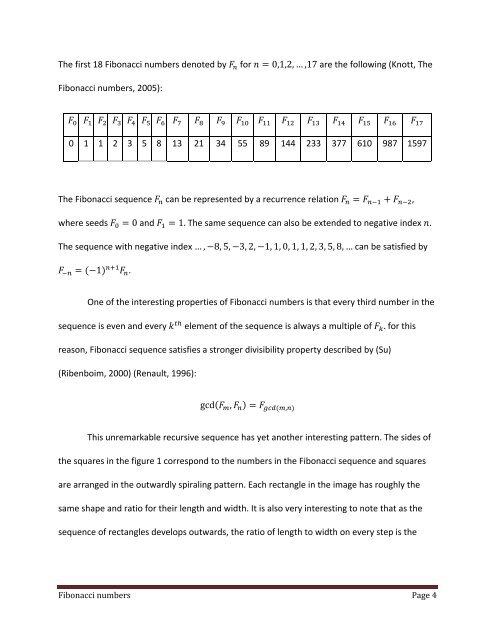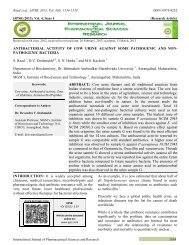fibonacci-numbers
fibonacci-numbers
fibonacci-numbers
You also want an ePaper? Increase the reach of your titles
YUMPU automatically turns print PDFs into web optimized ePapers that Google loves.
The first 18 Fibonacci <strong>numbers</strong> denoted by for 0,1,2, … ,17 are the following (Knott, The<br />
Fibonacci <strong>numbers</strong>, 2005):<br />
<br />
0 1 1 2 3 5 8 13 21 34 55 89 144 233 377 610 987 1597<br />
The Fibonacci sequence can be represented by a recurrence relation ,<br />
where seeds 0 and 1. The same sequence can also be extended to negative index .<br />
The sequence with negative index …,8,5,3,2,1,1,0,1,1,2,3,5,8,… can be satisfied by<br />
1 .<br />
One of the interesting properties of Fibonacci <strong>numbers</strong> is that every third number in the<br />
sequence is even and every element of the sequence is always a multiple of . for this<br />
reason, Fibonacci sequence satisfies a stronger divisibility property described by (Su)<br />
(Ribenboim, 2000) (Renault, 1996):<br />
gcd , ,<br />
This unremarkable recursive sequence has yet another interesting pattern. The sides of<br />
the squares in the figure 1 correspond to the <strong>numbers</strong> in the Fibonacci sequence and squares<br />
are arranged in the outwardly spiraling pattern. Each rectangle in the image has roughly the<br />
same shape and ratio for their length and width. It is also very interesting to note that as the<br />
sequence of rectangles develops outwards, the ratio of length to width on every step is the<br />
Fibonacci <strong>numbers</strong> Page 4









